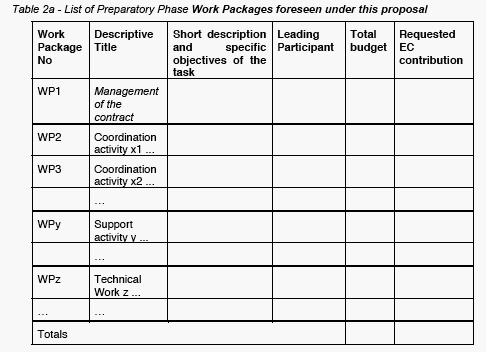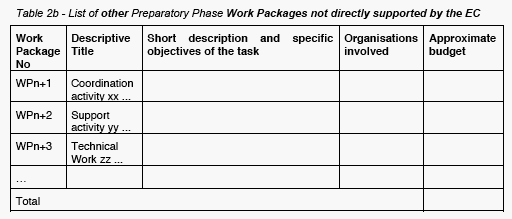Information for Participants
Participants are required to conclude a Consortium Agreement.
Participants will receive some EU contribution.
For the technical tasks, normally a 50% self-contribution would be expected from these partners, which was the typical basis for FP6 projects. Taking into account the 60% overheads for R&D in FP7, this practically means that the self-contribution will be around 20% only.
Needs from PARTICIPANTS at the Proposal Stage
IMPORTANT ----> THE PROPOSAL SUBMISSION PROCESS: The final proposal (Parts A & B) is submitted electronically using the EPSS (Electronic Proposal Submission Service) by the Coordinator of the project. A user guide to EPSS is available here. The Coordinator will register into the system and will get the coordinator and partner passwords. Passwords are linked to only one proposal. Partners will fill online the A2 form. They can view the proposal at any time, but only edit their corresponding A2 form.
These 2 forms are requested from the participants:
1. A2 form (doc) for participants. An A2 example form, as filled out for CERN (doc) 2. Participant Description (doc)
-------
The Coordinator fills in the Part B of the proposal; participants will also appear in the following sections:
Participants appear listed in Table 1a (List of Participants: Participant number, Organization, Name and Country).
Participants appear in Table 2a (List of Work Packages), whenever they are a LEADING PARTICIPANT of a Work Package.
Participants appear in Table 2b (List of other Work Packages not directly supported by the EC), whenever they are INVOLVED in a Work Package.
Participants appear in Table 3c (Summary of staff effort) giving the number of total person months for the Work Package in which they are involved.
Needs from PARTICIPANTS during the Project Lifetime
The formal reporting requirements are included in the project contract and its appendices. It mainly consists of periodic (annual) and one final financial and progress reports, in very similar form to the reporting in FP6.
The reports are to be prepared by the coordinators in collaboration with the partners. Reports must be submitted by the Co-ordinator within 45 days from the end of the reporting period. The active spread sheets for reporting are supplied by the EU. Contained there are the detail and summary forms for a participant as well as the consolidation forms for the Co-ordinator.
Annual Report
The Annual Report covers each successive period of 12 months from the contract start date. It is composed of the following parts:A. Activity report (Partner Level) - The periodic activity report is a report where the partner summarizes annually the specific contribution to the project in terms of work package progress and specific outputs. This report will be collated from every partner and serve as an overview on the overall progress of the project.
It includes:
- a progress report,
- the list of deliverables,
- a report on the use and dissemination of knowledge.
B. Management report (Work package Level) - The periodic management report is a brief description of the work performed during the reporting period, which should be addressed at the work package level, and the work specification should be detailed enough to justify the resources employed. This report should take into account any major cost items such as important equipment purchases, major travel costs, large consumable items etc., justifying their necessity to the project.It includes:
- Form A – A detailed Actual/Budget Cost table with variance explanations.
- Form C - Financial Statements giving summary Static, Cost and Receipts Information with specific reference to Audit Certification. The broad objective is to provide a detailed justification of the costs incurred and of the resources deployed in the first year by each partner, linking these to activities and justifying their necessity. It may require an Audit certificate. - Every partner is obliged to deliver an audit certificate either at the end of the project or annually if the funding will exceed 150.000 E. The audit certificate has to be submitted with the Form C and must cover the costs incurred during all precedent periods for which audit certificates have not been provided.
- A summary financial report.
C. Report on the distribution of the Community financial contribution.
Final Report
In addition to the annual report for the last reporting period, the consortium shall submit a Final Report to the Commission after the end of the project. This report summarises the project's activities over its full duration. It includes the following parts:A. Final activity report, covering the main aspects of the work, objectives, results and conclusions, including a summary of all these aspects.
B. Final management report consolidating the claimed costs of all the contractors in an aggregate form covering the entire duration of the project.
C. Final report on the distribution of the Community’s contribution consolidating the funding distributed to each contractor over the entire duration of the project.
Last Updated April 25, 2007 by MC



